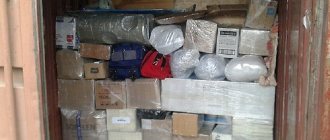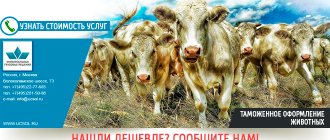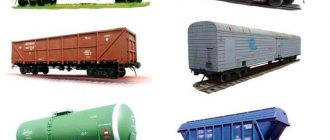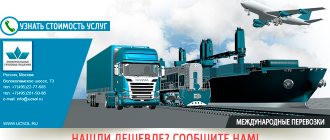The TIR sign on trucks means that the cargo is delivered using a TIR Carnet. It is provided for by the Customs Convention on International Transport, adopted in 1975 to facilitate the transport of goods across state borders. The convenience and simplicity of the new rule were appreciated in many countries of the Eurasian and African continents, and in America. Now the TIR convention operates in more than 50 states, allowing carriers to cross borders with minimal time costs.
What is Carnet TIR, or TIR Carnet? How does the TIR system work?
TIR stands for International Road Transport, or TIR. What is colloquially called a “TIR”, meaning a notepad with loose leaves, is officially called the TIR Carnet or Carnet TIR. This book is just one element of a rather complex mechanism regulating international road transport. This mechanism also insures risks associated with international transportation.
TIR itself is “a universal transit system that allows the transit of goods from the country of departure to the country of destination under customs seals. At the same time, customs control measures are recognized throughout the entire transportation.”
The TIR system was developed in Europe after the Second World War to simplify trade and transport and was introduced in several stages. It minimizes administrative and financial costs, while simultaneously providing participating countries with an international guarantee of payment of customs duties.
International road transport under the TIR procedure is carried out in accordance with the TIR Convention (the Russian text of the convention begins on page 195), which was developed under the auspices of the UN Economic Commission for Europe in 1954. The Convention was finally adopted in 1975 and came into force in 1978.
The International Road Transport Union (IRU, or IRU), headquartered in Geneva, is responsible for the implementation, operation and development of the TIR system. The IRU operates through its regional offices. In Russia it is the Association of International Road Carriers (ASMAP).
Although the Russian Federation has also acceded to the Convention, since 2013 the validity of TIR Carnets on its territory “in practice” has been seriously limited.
International road transport - who can do it and how
The procedure for road carriers to obtain permission to carry out international transportation is established by a special Government Regulation on admission to such transportation.
Currently, Regulation No. 505 of May 24, 2012 is in effect. Some necessary excerpts from it are given below. Basic conditions that must be met to obtain a permit for international road transport.
- Availability of vehicles owned by the applicant and meeting the requirements of current regulations.
- Competence of persons responsible for cross-border road transport.
- Availability of an insurance policy from the carrier.
What is needed to obtain a permit for international road transport:
- application for issuance of a certificate;
- confirmation of the owner's rights or other legally strong justification for ownership of vehicles;
- documents on state registration of the relevant vehicles;
- insurance policy;
- documentary evidence of the professional competence of the responsible employee;
- description of the attached documentation.
In order to obtain permission to perform international road transport, the applicant submits the above documents to the local branch of Rostransnadzor at his own registration address.
Are you interested in what documents may be required from the carrier for control? The “Administrative Regulations for Supervision in the Sphere of Transport” approved by the Ministry of Transport of Russia contains clause 11, which contains a detailed list of necessary documents required when importing or exporting various goods to or from Russia.
What does TIR Carnet or TIR Carnet look like?
Cover of the TIR Carnet (click on the image to enlarge)
TIR Carnet (TIR, TIR Carnet) - is a large format notebook and consists of:
- Dark yellow covers
- Yellow cargo manifest (not used for customs purposes)
- Paired white and green tear-off sheets with spines
- Protocol
- Back cover with tear-off section
The TIR Carnet has a unique number consisting of two letters of the Latin alphabet and seven numbers. The validity period of each TIR Carnet is limited. The expiration date is indicated by a stamp on the cover of the notebook. The validity period refers to the last date when a TIR can be opened and transportation under the TIR procedure can begin. NOTE: The TIR Book notebook is relatively inexpensive, like any high-quality sketchbook, but the very possibility of using TIR Books, i.e. being a full-fledged participant in international road transport under the TIR system is not a cheap pleasure. It is necessary to obtain permission for international transportation from the Federal Customs Service. After which the transport inspection will issue you an access card for international cargo transportation for each tractor. You will also need to pay a fee and become an accredited member of ASMAP. In addition, you need to obtain customs certificates for trailers, not to mention the fact that all your vehicles must be certified for international transport.
Sample book
If the carrier decides to fill out the sections of the TIR Carnet on his own, you can use samples to avoid mistakes. We offer the covers of the book, the cargo manifest, tear-off sheets and spines, the accident report and the back cover, and carefully read the sections of the document. Such preparation will help to avoid mistakes and reduce the time for registration. If you have no experience in document preparation, be prepared to carefully study a multi-page invoice and shipping documents. A faster and more reliable option is to contact experienced specialists.
1. Sample of a fully completed TIR Carnet
TIR Carnet cargo manifest
Continuous sheet of TIR TIR Carnet (click on the image to enlarge)
TIR Carnet contains all the basic information on international cargo transportation:
- Country of departure and country of destination
- Customs office of departure and customs office of destination
- Sequence of customs clearance
- Cargo data: description, HS code, gross/net weight, number of packages
- How many pieces of cargo and to which customs office should these packages be delivered?
- List and numbers of shipping and transport documents
- Registration number of a vehicle engaged in international road transport
- Numbers of applied seals, seals and other customs marks
If you have experience, you can fill out the TIR yourself (detailed instructions). However, since this often requires carefully reviewing multi-page invoices, packing lists, or (God forbid) crooked CMRs, as a rule, this is done by specially trained people - customs freight forwarders. Moreover, in principle there should not be any blots that allow for double interpretation of data in the TIR. All corrections are made only by crossing out erroneous information. After correcting errors or adding new information, changes on the TIR pages must be certified by a customs seal. Otherwise, the TIR is invalid. There are 4-, 6- and 14- and 20-sheet TIRS, depending on how many times during the transportation you will have to open/close the TIR procedure. Accordingly, their price differs (the price of the notepad itself). When choosing a TIR, it is important to know in advance how many sheets you will need, and for this, in turn, have a clear idea of the route and understand how transportation through the TIR occurs in practice.
Filling procedure
Information in the TIR Carnet (TIR Carnet) is entered by the IRU representative office (in Russia - ASMAP), its owner, as well as customs authorities. Filling out the TIR Carnet is carried out as follows:
- ASMAP fills out points 1-5 on the cover.
- The responsibility for filling out 6-12 points of the cover, yellow cargo manifest of the carnet lies with the owner of the Carnet TIR (TIR carnet).
- Points 16-23 of the tear-off sheet and the white spine are filled out by a representative of the customs authorities of the countries of departure, transit and destination.
- In paragraphs 24-28 of the tear-off sheet and the green spine, information is entered by customs officials of the country of departure and destination of the cargo.
How does the TIR Carnet work?
When passing through customs, sheets are torn out of the notebook one by one. The driver is left with the stubs in the notebook. Sheets are counted in pairs: white and green. First sheet = TIR open; second sheet = TIR closed. In an open shooting gallery there is an odd number of roots, in a closed shooting gallery there is an even number. The opening of a shooting range is often confused with the actual start of transportation, and the closing of a shooting range with its completion. THIS IS WRONG.
We are talking specifically about transportation under the TIR procedure. Both before and after this, transportation may follow a different procedure. In order not to rack your brains, be guided by the following formula when counting TIR sheets: 1st sheet = come under national customs control, start the TIR procedure, 2nd = leave national customs control, complete the TIR procedure.
Each customs zone therefore has an even number of tear-off sheets. You cannot leave the customs zone with an open shooting range - it must always be first open and then closed for this zone. Let's consider an example of transportation via TIR, sequentially passing through three customs spaces: Switzerland—EU—CU (Customs Union with two delivery points in the Russian Federation).
- In Switzerland, you get cleared by customs (go through the customs clearance procedure), open a TIR (issue a TIR Carnet), apply seals and come under Swiss customs control, starting the TIR procedure. The first sheet is torn off. At the exit from the Swiss customs area, the second sheet is torn off and the TIR procedure is closed.
- At the entrance to the EU, customs opens the TIR procedure for the EU customs area - the third sheet is torn off. In Poland, upon leaving the EU, the TIR procedure is closed again, tearing off the fourth sheet. When entering the Customs Union, the TIR procedure is opened for the third time and the fifth sheet is torn off.
- At the first customs office of destination in the Russian Federation, the TIR procedure is closed, the sixth sheet is torn off, the seals are removed, part of the cargo is unloaded (if you have several delivery points), then the seals are applied again and the TIR is opened for the fourth time, tearing off the seventh sheet.
- Finally, at the second and last customs office of destination in the Russian Federation, the TIR procedure is closed for the last time, the eighth sheet is torn off, the seals are removed and the remaining cargo is unloaded. Upon returning from the flight, the used TIR is returned to ASMAP, which keeps records of them.
As a result, you went through three customs zones, but came under customs control and left it four times: in Switzerland, in the EU, and twice in the Customs Union. Each time you needed 2 sheets to first open and then close the TIR procedure - a total of 8 sheets.
If you, for example, took a TIR carnet with six sheets, it would only be enough to reach the first customs office of destination in the Russian Federation, and then you would have to go according to a different procedure. If for some reason you decided to pass through Ukraine on the way, which is not yet part of the EU or the Customs Union, you would need an additional 2 sheets, and you would spend 10.
When planning transportation, you need to remember that, regardless of the number of destination customs sheets, there can be no more than three . For customs offices, the TIR Carnet has only 4 columns, including the customs office of departure. And even if you have a 20-sheet TIR, nothing will change. The sequence of customs is also very important. Once the TIR is filled out and opened, it is extremely difficult to change the order of customs clearance and there is a risk of running into an administrative offense.
How the TIR system works in Russia
Since 2013, the operation of TIRs in the Russian Federation has been significantly limited, and in the main area - the area of imports. This was preceded by a protracted conflict between the Federal Customs Service of the Russian Federation and ASMAP. As a result, the Federal Customs Service announced that, regardless of the value of the cargo, TIR in Russia is no longer a sufficient measure of security for the payment of customs duties.
In other countries of the Customs Union - Belarus and Kazakhstan - TIRs operate as before, without restrictions. This led to a rather unusual result: when importing goods into the Russian Federation, customs still works with the TIR, but only for closure. In other words, the Federal Customs Service cannot but recognize the TIRs opened in Belarus, but the TIRs themselves no longer open.
As a result, at the moment you can only get to the first Russian customs using the TIR. Depending on the situation, this can be either a customs office at the border or the first customs office of destination according to the TIR (the so-called internal customs post).
In most cases, when you enter the Russian Federation, bypassing the neighboring states of the Customs Union (Belarus or Kazakhstan), the TIR will be closed to you at the border. Until recently, the exception was the Brusnichnoye transport station on the border with Finland. There they let you through with the shooting gallery and you can get to the first internal customs office. If you enter the Russian Federation through neighboring states of the Customs Union, for example, Belarus, then in this case you will bypass the Russian border, accordingly, the TIR will not be closed and you can take it to the first customs office of destination in the Russian Federation.
But one way or another, after passing through the first Russian customs checkpoint, be it border or internal, the TIR is closed. For subsequent delivery points, you will have to open transit declarations and provide a guarantee of payment of duties.
Errors when filling out
When filling out the TIR Carnet, you should be extremely careful: blots and corrections are not omitted. If corrections are necessary, the carrier makes them, certifying the accuracy of what is written with his signature and lowercase seal. The corrections are then checked and certified by customs authorities. Any illegible entries allow for discrepancies in reading, which means they make the TIR Carnet invalid.
In addition, all information provided in the document must be truthful, thorough and accurate. Any distorted, false, or incompletely provided information may lead to cancellation of the book and a fine from ASMAP imposed on the carrier. And the transported cargo may be delayed at the border while the documentation is being reissued, which will cause missed delivery deadlines.
Traps on the Russian border
At the same time, special attention must be paid to a very unpleasant situation when a carrier heading to the Russian Federation ends up in a customs convoy in Belarus along the way. Many carriers have already been burned by this and, unfortunately, many more will burn out.
The point is that the Belarusian convoy takes the carrier not to the customs office of destination, but simply to the first Russian customs office - usually this is one of the posts on the Russian-Belarusian border. There, the shooting gallery is forcibly closed and no amount of persuasion will help.
That is, you haven’t even reached the first customs office of destination in the Russian Federation, but the TIR is no longer there and it is not clear what procedure you will follow next, although in order to avoid this you specifically traveled through Belarus. It is necessary, willy-nilly, to draw up a transit declaration and a guarantee of payment of customs duties.
At the same time, after the closure of the TIR at customs, you are given no more than three hours to open a new transit procedure. If you don’t have time, go to the temporary storage warehouse, and then, depending on your luck, maybe you’ll just stand in a non-free parking lot, or maybe they’ll unload you into a warehouse, so that later, when you finally formalize everything, they’ll load it again and take your money again .
In itself, correcting all the required documents is, in principle, not difficult. Guarantees for customs transit, for example, are in charge of insurance. Now its agents, subagents and sub-subagents can be found at almost every customs post. They, as a rule, also make a transit declaration.
If your cargo is not particularly valuable and you are not going very far - somewhere in central Russia - consider that you got off lightly. But if it turns out that the cargo is subject to additional customs control measures and you are heading to, say, Kazakhstan, you are in trouble.
The same thing can happen at any border customs post if you enter Russia directly, bypassing Belarus and Kazakhstan. Until 2013, such difficulties did not arise. However, ASMAP and IRU do not lose hope of turning the situation around and restoring the full validity of TIR Carnets on the territory of the Russian Federation.
What does TIR mean in logistics, and who can provide such a service?
The main advantage of such a system is that it allows you to speed up the process of transportation by truck by reducing the number of inspections at intermediate customs offices and the number of requirements that are required for international transit. This means that if you need delivery from China to Ukraine, the cargo transported in this way will be less delayed at transit stops and delivery will be much faster. This is convenient for both customs services and the cargo owner.
Of course, it will not be possible to simply provide services guided by the system. To obtain permission, a company must meet at least three criteria:
- have in the fleet vehicles that belong specifically to her and meet all the requirements of existing standards;
- have competent staff who can be responsible for the required type of transportation;
- have an insurance policy.
Only if these criteria are met, a company has the right to collect and submit documents for a permit.
Warranty restrictions
TIR is, without a doubt, very convenient, however, as noted earlier, it is not a universal solution in the field of international road transport. In particular, the TIR Convention guarantees national customs authorities the payment of customs duties in the amount of up to 60 thousand euros. If fees exceed this amount, the TIR is no longer valid and additional security is required. In Belarus, as a rule, this is a customs convoy, the cost of which is about 300 USD. For this money, the car with your cargo is escorted through the territory of Belarus to the border with Russia. The registration of the convoy is carried out exclusively by the Beltamozhkonvoy enterprise, whose representatives are located at all border checkpoints of Belarus.
In Russia, the most commonly used are guarantees and guarantee certificates. Guarantee certificates are issued by the recipient of the cargo at the customs office of destination after preliminary payment of customs duties. In this case, VAT is charged not at 18% as for customs clearance of cargo, but at 20% as for transit. Guarantee guarantees, for their part, can be issued by the carrier themselves at all customs posts of the Russian Federation through agents and subagents of the insurance company. (Usually, these are the same customs brokers who have received the appropriate license). The cost of the guarantee depends on the ratio of the amount of customs duties and the distance to the customs office of destination.
Obviously, TIR is not suitable for expensive cargo. Therefore, it is important to know the cost of the cargo and its code according to the Commodity Nomenclature of Foreign Economic Activity in order to calculate the amount of customs duties in advance and not get into trouble. Fees are calculated according to the formula: duty according to the HS code + 20 percent VAT on (cost of goods + duty) + customs clearance fee.
State control
Issues of state control are defined in Federal Law No. 127-FZ of July 24, 1998, on the basis of which supervision of international road transport throughout the Russian Federation is carried out.
The law contains separate articles regarding the ownership of vehicles (vehicles) by Russian or foreign carriers, and also indicates the starting and ending points. For example, for Russians who own a vehicle , this means traveling from the territory of the Russian Federation across the border of a foreign state or in the opposite direction. For foreign carriers, this means travel to and from Russian territory or transit through regions of the Russian Federation.
Who guarantees what and to whom?
Many people tend to consider TIR insurance guarantees as a kind of armor that, if something happens, will protect them from all troubles. In fact, everything is somewhat more complicated. The IRU, of course, guarantees national customs authorities the payment of customs duties of up to 60 thousand euros. But the beneficiary is not the carrier or the owner of the cargo, but the national customs office. Moreover, nothing relieves the carrier from liability and financial obligations in the event of a violation of the TIR Convention.
For each TIR Carnet received, carriers pay an insurance premium of 12.5 Swiss francs to the Russian representative office of the IRU, the ASMAP Association. All these funds are then transferred to Ingosstrakh Insurance Company. However, the coverage provided under the Insurance Agreement is not insurance in the usual sense of the term. This is a guarantee that does not provide for the carrier to receive insurance compensation. The carrier pays for insurance for which he is not owed anything.
The beneficiary of the insurance contract is the so-called “TIR guarantee chain”: ASMAP, IRU and intercity insurers IRU. Representatives of the guarantee chain receive insurance compensation from Ingosstrakh when they have paid customs claims regarding TIR Carnets for the carrier. At the same time, Ingosstrakh makes a recourse claim against the carrier that paid it for insurance in order to receive compensation.
What is “permission”
“Permission” (this is a slang term, by the way) is a one-time, two-way permit that allows a driver to enter another country. Issued to the carrier company and a vehicle with a trailer. You can obtain permission from the Ministry of Transport of the country you plan to enter.
The types of permits depend largely on countries' policies. For example:
- Poland, Germany, the Netherlands, according to this document, allow transit, loading and unloading;
- Hungary, Slovenia, and the Czech Republic allow either transit or loading/unloading (if both are required, you need to obtain two “permissions”);
- Austria requires a separate document for each action.
At the same time, the number of “permissions” is limited. Ministries of transport annually set limits on how many documents they can issue to representatives of other states. For the “permission” itself, you need to pay a small fee of about 10 euros, but the value of the document is extremely high, without it you will not be able to enter or drive through the country in a truck.
As a rule, “permits” are bilateral; they allow a carrier from one country to enter another. But tripartite documents also exist. For example, if you need to pick up cargo in Ukraine, unload it in Poland, and the carrier is a company from Germany, then just such a document is drawn up.
In the last few years, “permissions” have not been used very often. They were replaced by another document called the ECMT.
Preliminary Electronic Notification of EPI
Unfortunately, it is impossible to enter the Customs Union by simply showing the TIR to the customs officer at the border. To make life easier, since 2012, customs introduced the so-called Electronic Preliminary Information (EPI), which also applies to transportation within the TIR. EPI is a kind of electronic declaration that contains all the data on cargo and transportation. After submitting the EPI, customs assigns the shipment an individual MRN number (Movement Reference Number), which is displayed either in numbers or in a barcode. The driver provides this number at the border, and the customs officer easily finds the corresponding EPI in his database. Having checked its data on its computer with the data in the accompanying documents, customs either confirms the MRN or sends the EPI for correction.
To work with EPI, the IRU has developed its own online service TIR-EPD. Only authorized users can use it. However, if you have already been given the TIR itself, it is not difficult to gain access to the TIR-EPD. Logins and passwords are issued by the regional offices of the IRU - in Russia this is ASMAP. The TIR-EPD manual can be found here if desired.
Important: you can apply for an EPI at TIR-EPD only if you are going through the TIR. If TIR is not used, for example, transportation is carried out under a transit declaration, you need to choose other programs or the Portal for electronic provision of information of the Federal Customs Service of the Russian Federation (https://edata.customs.ru/Ed/). In turn, these programs can submit an EPI for the TIR.
Finally, if you do not want to contact the EPI, any broker at the border checkpoint is ready to do it for you. The cost varies depending on the number of HS codes.
TIR Carnet tracking – SafeTIR system
In the mid-90s, due to an increase in trade volume and the number of road carriers carrying out transportation under the TIR, additional control and management tools were created. One of them was the electronic system for monitoring the use of TIR Carnets - SafeTIR. SafeTIR through the CUTE-Wise application (https://www.cutewise.org/) allows you to check the status and validity of each TIR Carnet, at any time in real time.
The main objectives of the SafeTIR system are:
- providing confirmation of termination of TIR transport
- facilitating the verification of the TIR Carnet, in particular the customs stamp on the last counterfoil
- risk management in the TIR system by electronically tracking the location of the TIR Carnet
- providing a quick and effective tool to identify potential violations and prevent their recurrence
- internal procedures for investigating violations for each specific TIR Carnet are simplified.
Information regarding the termination of a TIR transport is transmitted by national customs authorities to the IRU. After this, the data becomes available to all participants in the TIR system: customs authorities, issuing and guaranteeing associations, insurers, transport operators. As noted on the IRU website, in 2012 the average time for data transfer to the system was 1.5 days. In doing so, the IRU intends to ensure that all participating countries transmit SafeTIR data no later than the same day on which the TIR operation was terminated.
SafeTIR allows customs authorities to check the status of each TIR Carnet before accepting the carnet for processing.
What goods cannot be transported using a book?
A uniform ban for all countries is the transportation of alcohol and alcohol-containing products using TIR documents. The only exceptions are wine and beer. Tobacco products and tobacco are also prohibited in all states.
Separate bans have been established in the European Union. Here, using a TIR Carnet, it is prohibited to transport:
- Deep-frozen cattle meat.
- Concentrated and sweetened dairy products (milk, cream).
- Milk fat and butter in all forms.
- Bananas, fresh and dried.
- Beet and cane sugar, chemical sweeteners.
- Ethanol with an alcohol content of more than 80%.
- All products from the high-risk list: meat, dairy products, baby formula, butter and margarine.









